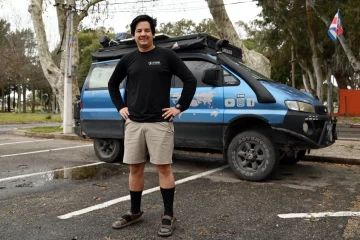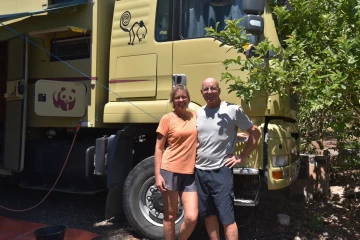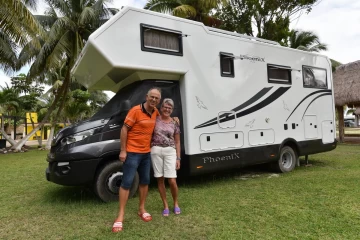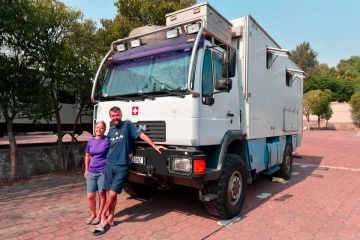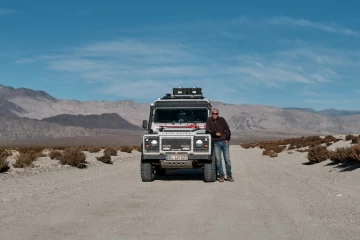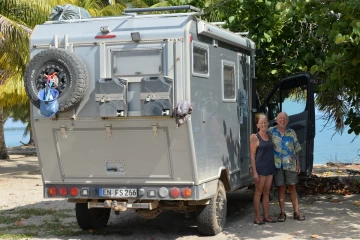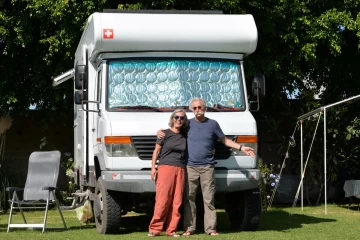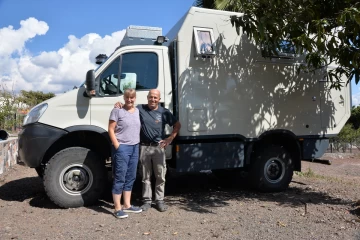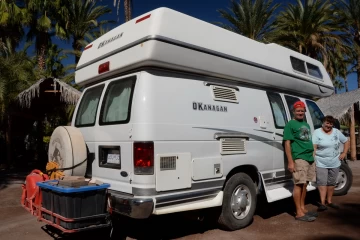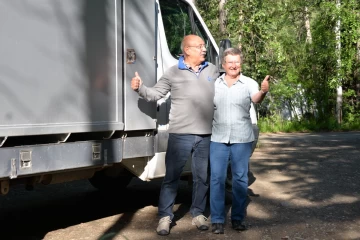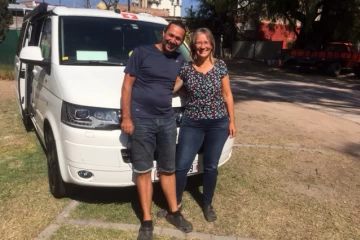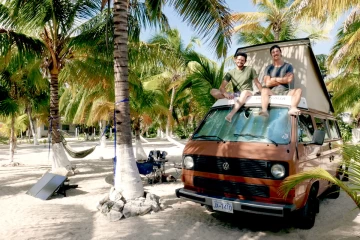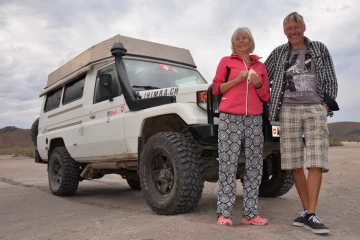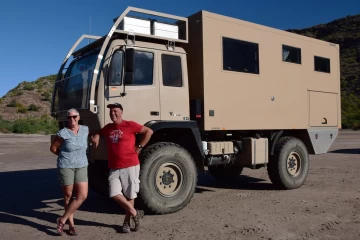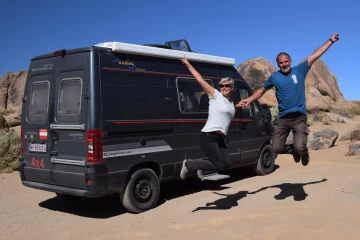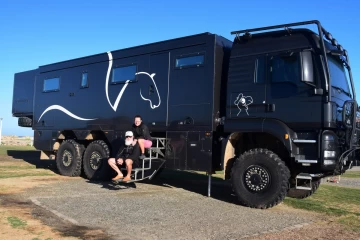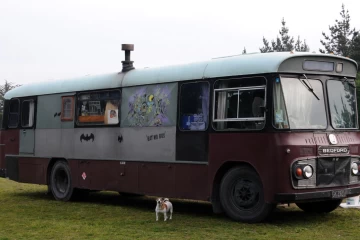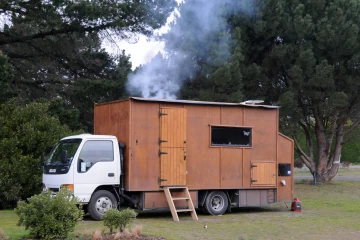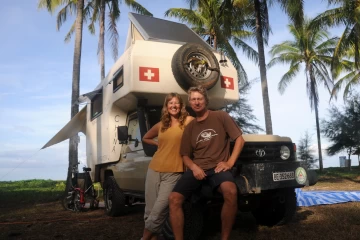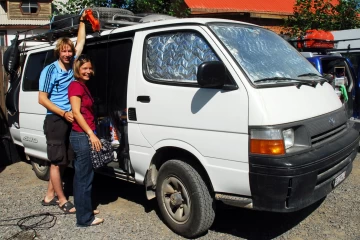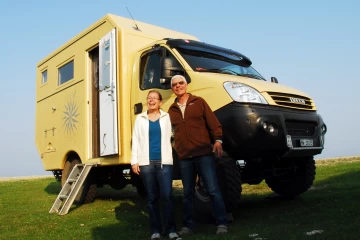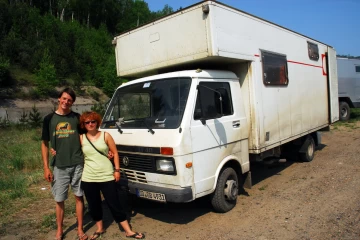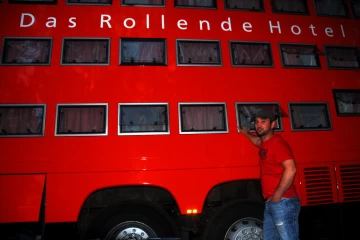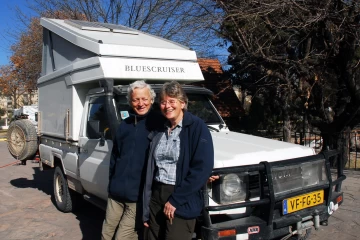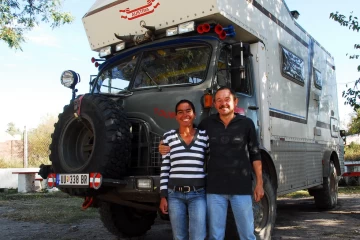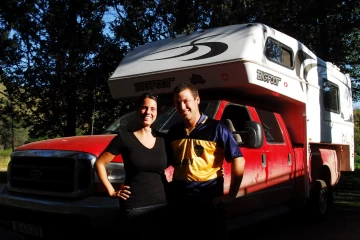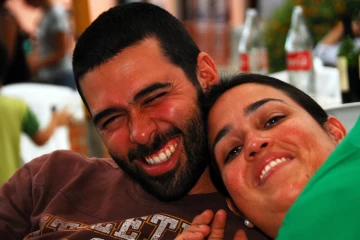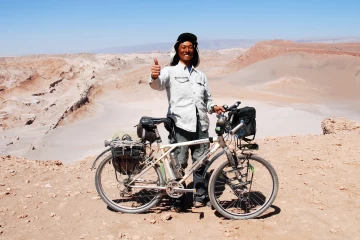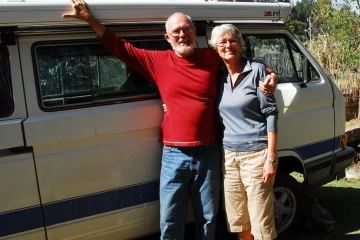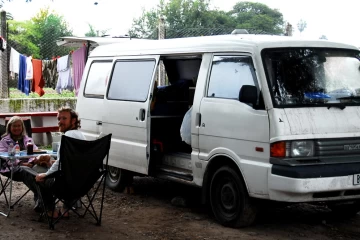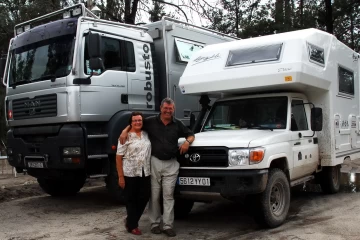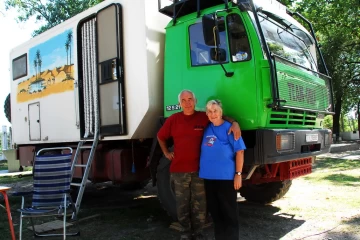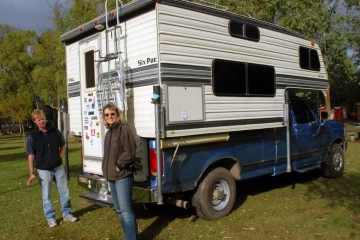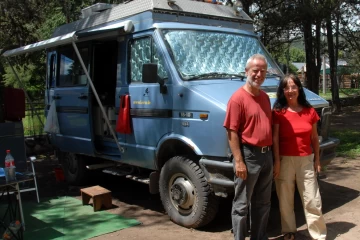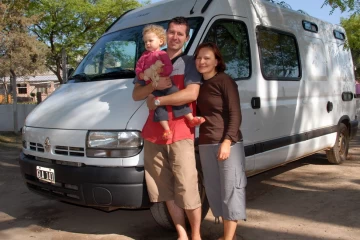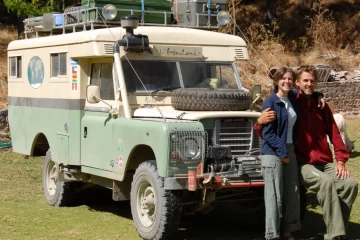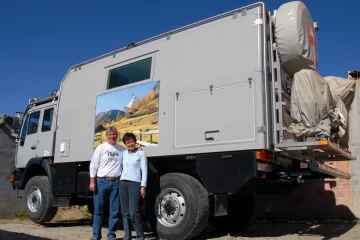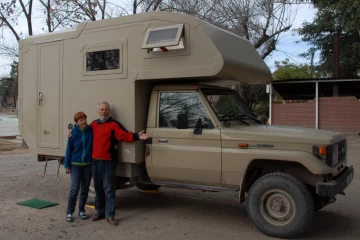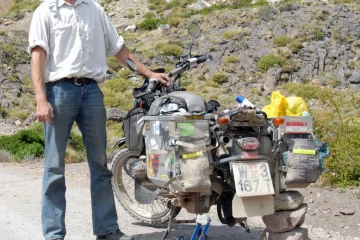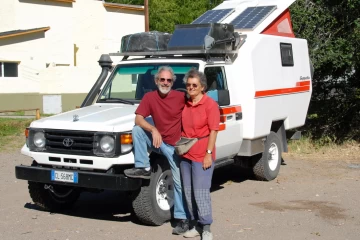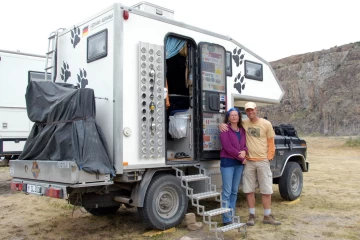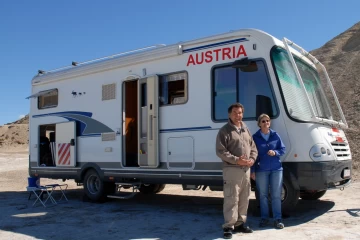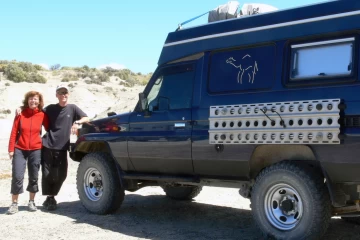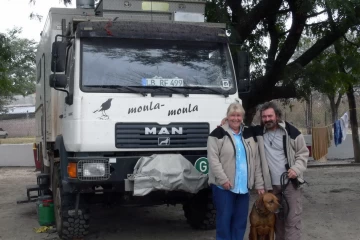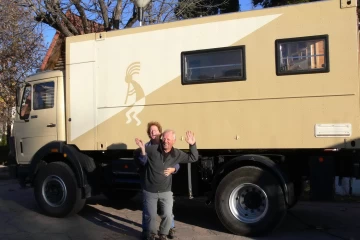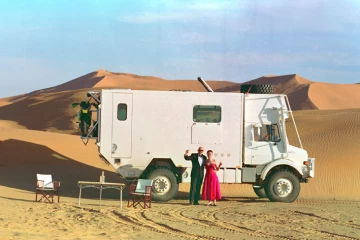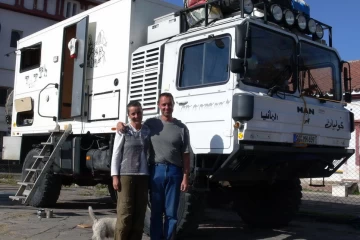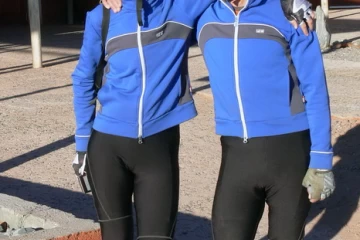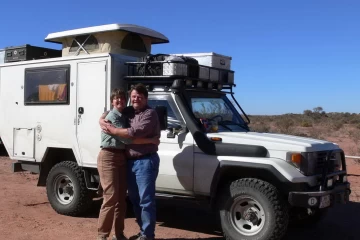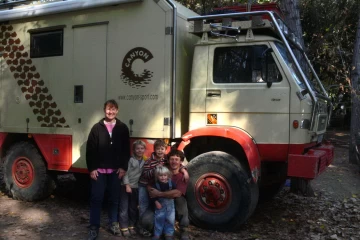Brazil: Cataracts, Donauschwaben & Camilla's Camp
May 2023

Shopping Paradise Ciudad del Este
To replace our disappeared laptop, we took a cab from Camping International in Foz do Iguaçu, Brazil across the Bridge of Friendship to the shopping paradise of Ciudad del Este, Paraguay.
What's going on there in the more than 3,500 shops is very special. An unbelievable hustle and bustle and crowds in the countless centers.
It's good if you've done your research beforehand and have a clear idea of what you want. Only a few devices are effectively displayed. We wanted to pay our purchased equipment in cash with US dollars. But there we had made the calculation without the tricky cashier. She didn't accept more than half of the dollar bills that we presented, reason traces of usage.
The return trip with our cab took forever because of the extreme border traffic. Street vendors offer all kinds of things, even Viagra. But there was no customs control at the border. Wouldn't be possible either, the traffic would come to a complete standstill, which nobody wants.

Iguaçu Waterfalls
The Iguazú Waterfalls consist of 20 larger waterfalls as well as more than 200 smaller ones on an extension of more than 2 kilometers. Most of them are around 60 meters high. The larger panoramic view is from the Brazilian side. The main waterfall is called "Devil's Gulch" and is a U-shaped gorge 150 meters wide. During high water, as a result of erosion triggered by deforestation in Brazil, the water turns a striking brown.
The falls were included in the list of the Seven Wonders of the Natural World in 2011.
The wonder is shrouded in veil - but it can't be ignored: The floodwaters cascading down the Iguaçu Falls fill the air with loud booms and thunderous spray.

The 5 Villages of the Danube Swabians in Entre Rios Brazil
In wars around 1700 AD, the Habsburgs conquered large areas of land in south-eastern Europe, particularly along the lower Danube and where it flows into the Black Sea. To settle these areas, mainly Swabians from today's Baden-Württemberg were recruited. These built up a new existence with agriculture.
After the end of the First World War in 1918, the Austrian-Hungarian monarchy broke up and the territories, which had been under one government until then, were distributed to different countries (Hungary, Romania, Yugoslavia).
Things got even worse at the end of the Second World War, when Russia recaptured the Eastern Front and the Danube Swabians were expelled from their territories by the thousands or, in some cases, horrifically murdered. Survivors of this expulsion lived for seven years in 900 emergency shelters in Austria.
Many of the Danube Swabians still cherished the hope of returning to their homeland.
In 1951, Swiss humanitarian aid for Europe organized an alternative living project on a voluntary basis in Brazil. The aim was to colonize large areas there, to use them for agriculture and to establish a cooperative for the marketing of agricultural products. 500 families, 2446 Danube Swabians, applied and saw a way into a new future.
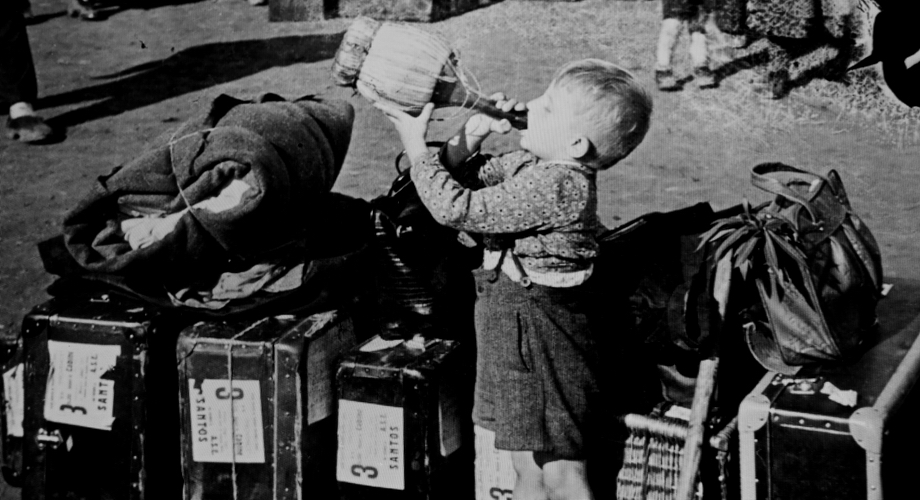
The selection criteria were:
- Primarily farmers and craftsmen, with preference given to families with many children.
- Applicants who had been involved in political or war crimes were not admitted.
- The Brazilian authorities have also allowed elderly people to emigrate.
- As a condition of participating in the project, the applicant should become a member of the cooperative and do community work for 1 year.
Seven ships took them across the Atlantic to southern Brazil, to Entre Rios near the city of Guarapuava. What they found there was jungle and no infrastructure whatsoever.
"The first found death, the second had hardship, and the third found bread."
From the beginning, it was determined that colonization would take place through the cooperative system. They founded the agricultural cooperative Agrária, which still exists today, and managed to overcome many obstacles through solidarity, strength and perseverance.
Still in Austria it was decided to form five villages like a chessboard, rather than staying on scattered farms. Each plot of land was half a hectare. The plot offered enough space for the construction of storage rooms, stables, vineyards/vines, orchards and gardens. 30 to 40 m of space was left for road construction. On the outskirts of the village, each family received 1 hectare of land, which was used as pasture.

In 1953 the distribution of the lands began, which each settler family could then farm independently, each farmer owned about 25 to 30 hectares of land. The period for payment of the lands was six years, with the first year as a grace period.
The system of chessboard land division, which did not take into account the topography, became one of the mistakes of the settlement work. Since plots were allocated by lot, the quality of production depended more on luck than on the farmer's work and knowledge. In the first years there were severe crop failures, so that by 1970 more than half of the families had left Entre Rios.
They nevertheless wrote one of the most remarkable stories about German immigration to Brazil. The Entre Rios district became the only community of Danube Swabians still existing today, like the one that once existed in Southeastern Europe. They kept their language, their dialects and their traditions. This gave rise to the name "Die Donauschwaben".

Camilla's Camp in Entre Rios
We spent a week in the mostly German-speaking Entre Rios at Camilla's Camp with Caroline and Walter. The camp is located below their modern, newly built house, in a terraced garden with a fishpond. Water, electricity and absolutely clean sanitary facilities. Comfortable pergola with barbecue and refrigerator.
On Mother's Day, we enjoyed a good lunch with Walter's family with about 2,000 citizens of Entre Rios at the modern event center.
Walter is the owner of a crop-spraying plane. He sprays fields with it in the region Entre Rios, but also in Sao Paulo.
On a trip to his farm 60 kilometers away, he told us many interesting things about the Danube Swabians.

Bread & Cafe Restaurant in Entre Rios
Walter's wife Caroline is the owner of the above restaurant. Daily lunch buffet and an afternoon buffet on Saturdays. The dessert buffet is an absolute hit. The restaurant is therefore also very well attended. Here we have taken some calories to us - super delicious!
Photos
Brazil: May 2023
-
2023 05 waypoints world trip brazil
Unique lighting conditions and moods at the Iguacu Falls.

-
2023 05 waypoints world trip brazil

-
2023 05 waypoints world trip brazil
-
2023 05 waypoints world trip brazil
Camping International in Foz do Iguacu, Brazil.
-
2023 waypoints world trip brazil
Tricycle motorcycles with camping trailers.
-
2023 05 waypoints world trip brazil
-
2023 05 waypoints world trip brazil
Beard care from a specialist.
-
2023 05 waypoints world trip brazil
-
2023 05 waypoints world trip brazil
Tropical forest with corresponding plants and animals.
-
2023 05 waypoints world trip brazil
-
2023 05 waypoints world trip brazil
-
2023 05 waypoints world trip brazil
-
2023 05 waypoints world trip brazil
-
2023 05 waypoints world trip brazil
-
2023 05 waypoints world trip brazil
-
2023 05 waypoints world trip brazil
-
2023 05 waypoints world trip brazil
-
2023 05 waypoints world trip brazil
-
2023 05 waypoints world trip brazil
-
2023 05 waypoints world trip brazil
-
2023 05 waypoints world trip brazil
-
2023 05 waypoints world trip brazil
-
2023 05 waypoints world trip brazil
-
2023 05 waypoints world trip brazil
-
2023 05 waypoints world trip brazil
-
2023 05 waypoints world trip brazil
-
2023 05 waypoints world trip brazil
-
2023 05 waypoints world trip brazil
-
2023 05 waypoints world trip brazil
-
2023 05 waypoints world trip brazil
-
2023 05 waypoints world trip brazil
-
2023 05 waypoints world trip brazil
-
2023 05 waypoints world trip brazil
-
2023 05 waypoints world trip brazil
Carpincho
-
2023 05 waypoints world trip brazil
-
2023 05 waypoints world trip brazil
-
2023 05 waypoints world trip brazil
The Ulmer boxes were simple wooden boats with a carrying capacity of up to 150 tons; who have been sailing down the Danube since the 16th century.
-
2023 05 waypoints world trip brazil
One of the Brazil Emigrant Ships.
-
2023 05 waypoints world trip brazil
-
2023 05 waypoints world trip brazil
-
2023 05 waypoints world trip brazil
-
2023 05 waypoints world trip brazil
-
2023 05 waypoints world trip brazil
Traditional costumes, which are still worn today by the Danube Swabians.
-
2023 05 waypoints world trip brazil
Museum at Entre Rios
-
2023 05 waypoints world trip brazil
-
2023 05 waypoints world trip brazil
...craftsmen were also welcome.
-
2023 05 waypoints world trip brazil
Aerial view of today's Entre Rios.
-
2023 05 waypoints world trip brazil
Araucaria
-
2023 05 waypoints world trip brazil
-
2023 05 waypoints world trip brazil
-
2023 05 waypoints world trip brazil
-
2023 05 waypoints world trip brazil
-
2023 05 waypoints world trip brazil
-
2023 05 waypoints world trip brazil
Walter with his own MAN tractor, which he uses to tow his spray plane.
-
2023 05 waypoints world trip brazil
Has a capacity of 1500 liters of spray fluid.
-
2023 05 waypoints world trip brazil
-
2023 05 waypoints world trip brazil
Walter flies over the huge fields while spraying at over 200km speed.
-
2023 05 waypoints world trip brazil
Impressive cockpit
-
2023 05 waypoints world trip brazil
-
2023 05 waypoints world trip brazil
In 1953, each emigrated farmer was allotted around 30 hectares of land by lot.Repayment period 6 years.
-
2023 05 waypoints world trip brazil
Bread & Café: The restaurant of Walter's wife Caroline.
-
2023 05 waypoints world trip brazil
-
2023 05 waypoints world trip brazil
-
2023 05 waypoints world trip brazil
-
2023 05 waypoints world trip brazil
One night we camped at a Posto = gas station with a hotel.
-
2023 05 waypoints world trip brazil
Side roads in Brazil.
-
2023 05 waypoints world trip brazil
Photos
Travelers
-
travellers.25 heidi and peter
Heidi & Peter, Switzerland - www.breezzze.com
Argentina: Cafayate 2025-09
-
traveller.25 margot and juerg
Margot & Jürg, Switzerland
Paraguay: Hohenau 2025-07
-
traveller.25 erich und sonja
Rene & Sonja, Switzerland - www.rsverlag.ch
Uruguay: Nueva Helvecia 2025-03 -
traveler.25 max
Max, Switzerland
Uruguay: Nueva Helvecia 2025-03 -
traveler.25 martin
Martin, Switzerland
Uruguay: Nueva Helvecia 2025-03 -
traveler.25 ewald
Ewald, Austria
Uruguay: Nueva Helvecia 2025-03 -
travelers.25 ursi and urs
Urs & Ursi, Switzerland - www.miles-away.net
Chile: Conaripe 2025-01 -
travellers.25 vera and stefan
Vera & Stefan, Germany
Chile: Cunco 2025-01 -
travellers.24 anja and jan
Anja & Jan, Germany -@ferneziele
Uruguay: Atlantida 2024-11 -
travellers.24 rita and robert
Rita & Robert, Switzerland
Uruguay: Atlantida 2024-11 -
travellers.24 corina and raphael
Corina & Raphael, Switzerland
Argentina: Posadas 2024-10 -
travellers.24 juergen
Jürgen, Germany - @leoncito_en_ruta
Paraguay: Hohenau 2024-09 -
travellers.24 peter and patricia
Patricia & Peter, Switzerland
Paraguay: Asuncion 2024-08 -
travellers.24 tanya and paul
Tanya & Paul, New Zealand - Polarsteps
Paraguay: Asuncion 2024-08 -
travellers.24 bernd and uschi
Uschi & Bernd, Germany - https://findpenguins.com/ :Uschi Klimaschka-Behrends
Brazil: Foz do Iguaçu 2024-07 -
travellers.24 alex jochen paul emil
Alex & Jochen with Paul & Emil, Germany
Paraguay: Hohenau 2024-05 -
travelers.24 karin and erich.jpg
Karin & Erich, Switzerland
Argentina: Salta 2024-02 -
travelers.24 anja and enrico.jpg
Anja & Enrico, Switzerland
Argentina: Posadas 2024-03 -
traveller.23 kees and jacobine
Kees & Jacobine, Netherlands - www.afri-kasa-fari.nl
Argentina: Salta 2024-02 -
reisende.23 ruth and walter.jpg
Ruth & Walter, Switzerland - www.reisevirus.info
Uruguay: Nueva Helvecia 2023-11 -
reisende.23 dorly and wolfgang.jpg
Dorly & Wolfgang, Switzerland - www: Maildinger's
Uruguay: Paraiso Suizo 2023-11 -
reisende.23 tina and felix.jpg
Tina & Felix with Filou, Switzerland - www.worldtour.news
Uruguay: Nueva Helvecia 2023-11 -
travellers.23 walter and andrea.jpg
Andrea & Walter, Germany
Uruguay: Jaureguiberry 2023-09 -
reisender192.23 emanuel.jpg
Emanuel, Costa Rica
Uruguay: Colonia del Sacramento 2023-09 -
travellers193.23 corinne and jean marc
Corinne & Jean-Marc, Switzerland
Argentina: Posadas 2023-08 -
rb191.24 johanna and klaus.jpg
Johanna & Klaus, Germany - Balu on world trip
Paraguay: Hohenau 2023-08 -
rb191.23 gabi frank.jpg
Gabi & Frank, Germany - www.paula-on-tour.de
Argentina: Posadas 2023-04 -
rb190.23 marcos joseane kopie.jpg
Marcos & Joseane, Brasil - @cadaviagemumaaventura
Argentina: Puerto Iguazu 2023-04 -
rb189.23 nadja franz karl de
Nadja, Franz and Karl, Germany
Paraguay: Hohenau 2023-03 -
rb188.22 lisi martin travellers austria
Lisi and Martin - www.stonestours.at
Argentina: Malargüe 2022-11 -
rb187.22 lydia ju travellers germany
Lydia and Ju
Argentina: Malargüe 2022-11 -
rb186.22 klaus traveller germany
Klaus and Klaus-Dieter
Argentina: Malargüe 2022-11 -
rb185.22 chris angie travellers ch
Angie and Chris, Switzerland
Uruguay: Soca 2022-09 -
rb184.22 traveller frank de
Frank, Germany
Uruguay: Soca 2022-09 -
rb183.22 holger ute travellers de
Ute and Holger, Germany
Uruguay: Soca 2022-09 -
rb182.22 uwe claudia mia de
Claudi and Uwe with dog Mia, Germany - www.cu-on-tour.de
Argentina: Posadas 2022-08 -
rb181.22 harald ulrike de
Harald and Ulrike, Germany
Argentina: Posadas 2022-08 -
rb180.22 juerg ch
Jürg, Switzerland
Argentina: Salta 2022-07 -
rb178.22 marion frank de
Marion and Frank, Germany - www.3paarschuheauf4raedern.de
Argentina: Salta 2022-06 -
rb177.22 conny geni ch
Conny and Geni, Switzerland - www.gecontour.ch
Argentina: Cafayate 2022-05 -
rb179.22 piaggiandoamerica mx
www.facebook.com/piaggiandoamerica/
Argentina: Valle de la Luna 2022-05 -
rb176.22 mathilde thomas fr
Mathilde and Thomas, France - www.lesribinou.fr
Argentina: Mendoza 2022-05 -
rb175.22 gabriele juergen de
Gabriele and Jürgen, Germany - www.kurmaontour.de
USA: Palm Desert 2022-01 -
rb174.21 regula chris caroline ch
Regula and Chris with daughter, Switzerland - https://www.polarsteps.com/CrisWeibel
USA: Santee 2021-12 -
RB173.21 Hermann Sibylle Switzerland
Hermann and Sibylle - www.d-hai.ch
Mexico: Santa Elena 2021-08 -
RB172.21 Arnold CH
Arnold, Switzerland
Mexico: Santa Elena 2021-06 -
RB171.21 Anke Wolfgang DE
Anke and Wolfgang, Germany - ankeundwolfgang.wordpress.com/
Mexico: Santa Elena 2021-05 -
RB168.20 Ursula Markus CH
Ursula and Markus, Switzerland - on the road since 2017
Mexico: Calderitas 2020-12 -
RB170.21 Isabella Thomas CH
Isabella and Thomas - www.awas-mgd.ch
Mexico: Tepotzotlan 2021-04 -
RB167.20 Robert Germany gooverland
Robert (Germany): www.gooverland.net
Guatemala: Antigua 2020-03
-
RB169.21 Rosy Edwin CH
Rosy and Edwin - on the way with Panamtour
Mexico-City: 2021-03 -
RB166.20 Catherine and Darryl Belgium USA
Catherine (Belgium) and Darryl (USA)
Guatemala: Antigua 2020-02 -
RB162 Hansueli and Ursula Switzerland
Hansueli and Ursula, Switzerland - www.mundolindo.ch
Mexico: Patzcuaro 2019-02 -
RB165.20 Angelika and Michael Germany
Angelika and Michael, Germany
Belize: Hopkins 2020-01 -
RB164 Doris and Hans Switzerland
Doris and Hans, Switzerland: www.ohne-grenzen.ch
Mexico: Oaxaca 2019-11 -
RB159 Yves and Cornelia switzerland
Yves and Cornelia, Switzerland
12.2018 La Paz, Mexico -
RB163 Rosemarie and Werner Switzerland
Rosemarie and Werner, Switzerland - www.rowefidibus.ch
Mexico: Santa Elena 2019-03 -
RB161 Oskar and Ursula Austria
Oskar and Ursula, Austria - www.oskarlehnertravel.news
Mexico: San Miguel de Allende 2019-02 -
RB160 Ruth and Beat Switzerland
Ruth and Beat, Switzerland - www.quer-dure.ch
Santa Elena, Mexico 10.01.2019 -
RB158 Josef and Josy switzerland
Josef and Josie, Switzerland: 12.2018 Mulege, Mexico
-
RB157 Norman and Emilia Panama
Norman (England) and Emilia (Costa Rica) from Panama:
11.2018 Mulege, Mexico -
RB156 martin and eva switzerland
Martin and Eva, Switzerland
www.martintschupp.com -
RB155 cyrill marion bueffelontour switzerland
Cyrill and Marion, Switzerland
bueffelontour.blogspot.com -
RB154 christian anita switzerland
Christian and Anita, Switzerland
-
RB153 bernd heike endlich on tour germany
Bernd and Heike, Germany
www.endlich-on-tour.com -
RB152 Rudolf lisabeth switzerland
Rudolf and Lisabeth, Switzerland
www.rulottli.com -
RB151 marcel jolanda switzerland
Jolanda and Marcel, Switzerland
-
RB150 glen roberta USA
Glen and Roberta, USA
-
RB149 Manuela Werner germany
Manuela and Werner, DE travel the world in stages.
-
RB148 Christl Werner schneckerl germany
Christl and Werner, DE
www.schneckerl-unterwegs.de -
RB147 die ausreiser Manfred Karin Deutschland
Karin and Manfred, Germany - on their journey around the world since 2013
www.die-ausreiser.de -
RB146 einmalrundum Thomas Stefan Schweiz
Thomas and Stefan, Switzerland
www.einmalrundum.ch -
RB145 Camerivan Marc Mathias Switzerland
Marc and Mathias, Switzerland
-
RB144 Felix Christine jhimba
Felix and Christine, Switzerland
www.jhimba.ch -
RB143 Fredi Vreni
Fredi and Vreni
-
RB142 Fritz and Monika Kopie
Monika and Fritz from Austria on their journey since 2001
-
RB141 die2hollys martina herman
Martina and Hermann
www.die2hollys.de -
RB140 uneplumeaugredesvents fabrice marie saimara serenn
Marie, Fabrice, Saimara and Serenn on their adventure tour.
www.uneplumeaugredesvents.blogspot.fr -
RB139 jump horizon anna maria und gerald
Anna Maria and Gerald on their one-year Panamerica Tour.
www.jumphorizon.com -
RB1387 Freddy und Rita
Freddy und Ritia - life dream travelling the world
www.reckfilm.de -
RB137 Doris und Manfred
Doris and Manfred with Bremach on the road.
-
RB136 Joerg und Babsi
Jörg and Barbara are travelling around the world.
www.welterfahrung.com -
RB135 Lieve und Dirk
Lieve and Dirk
www.worldtravellers.be -
RB134 Conny und Tommy
Conny and Tommy: www.mantoco.com
-
RB133 Schami und Rita
Schami and Rita: www.niggs.ch
-
RB132 Peter und Gabi mit Globi
Peter and Gabi: www.pegasus-unterwegs.ch
-
RB131 Grigu und Mirella
Mirella and Grigu (CH)
-
RB130 Norbert und Sonja
Sonja and Norbert (GER)
-
RB129.13 Neuseeland
New Zealanders
-
RB128.13 Neuseeland
New Zealanders
-
RB127.13 Neuseeland
Again New Zealanders
-
RB124.12Henry Ute D Namibia 08.2012
Henry and Ute (D): Namibia (NAM) 08.2012 www.hus-film.de
-
RB122.12 Coen und Mirjam NL
Coen and Mirjam (NL): Bankrut (TH) 07.2012
-
RB121.12 Akilifamily F Bankrut TH 06.2012
Akili Family (F)
-
RB119.12 Lorenz und Gisela CH Otres Beach TH 05.2012
Lorenz and Gisela (CH): Otres Beach / Sihanoukville (KH) 05.2012 http://logi.gotdns.ch
-
RB118.12 Frank und Kristiane D Bang Niang TH
Frank and Kristiane (GER): Khao Lak / Bang Niang (TH) 01.2012 www.fraenk-shui.de
-
RB117.12 Stephan Petra D Bang Niang TH 01.2012
Stephan and Petra (GER): Khao Lak / Bang Niang (TH) 01.2012 www.tvware.eu
-
RB116.12 Florian Bianca A Bang Niang TH 01.2012
Florian and Bianca (A): Khao Lak / Bang Niang (TH) 01.2012
-
RB115.12 Bruno CH Bang Niang TH 01.2012
Bruno (CH): Khao Lak / Bang Niang (TH) 01.2012
-
RB114.12 K lbi Christa CH Bang Niang TH 01.2012
Kölbi and Christa (CH): Khao Lak / Bang Niang (TH) 01.2012 www.chrigikoelbi.ch
-
RB113.11TH Heinz CH 12.2011
Heinz (CH): Pai (TH) 12.2011 www.heinz-buechler.ch
-
RB112.11 Hans und Nancy NL Golmud CN 10.2011
Hans and Nancy with Vausto (NL): Golmud (CN) 10.2011
www.wereldexpeditie.nl -
RB111.11 David und Claudia CH Ulaanbaatar MNL 09.2011
David and Claudia (CH): Ulaanbaatar (MNL) 08.09.2011
-
RB110.11 Martin AU Ulaanbaatar MNL 09.2011
Martin (AU): Ulaanbaatar (MNL) 08.09.2011
-
RB109.11 Martin AU 09.2011 Ulaanbaatar MNL
Heiko (GER): Ulaanbaatar (MNL) 08.09.2011
-
RB108.11 Heiko DE Ulaanbaatar MNL 09.1011
Heiko (GER): Ulaanbaatar (MNL) 08.09.2011
-
RB107.11 Dieter und Bayola D Ulaanbaatar MNL 08.2011
Dieter with Bayola (GER): Ulaanbaatar (MNL) 08.2011
-
RB106.11 Lutz und Gianna D Mongol Els MNL 08.2011
Lutz with Gianna (GER): Mongol Els (MNL) 08.2011
-
RB105.11 Voyage MNL Khovd MNL 07.2011
Voyage (MNL): Khovd (MNL) 07.2011
This year riding with his bike 4400km on gravel road. -
RB104.11 Didier und Barbara CH UlanBaatar MNL 07.2011
Didier and Barbara (CH): Ulan Baatar (MNL) 07.2011
www.pfusbus.com -
RB103.11 Toni und Nelly CH Baikalsee RUS 06.2011
Toni and Nelly (CH): Lake Baikal (RUS) 06.2011
-
RB102.11 Alex und Chris D Insel Olchon RUS 06.2011
Alex and Chris (GE): Olchon Island (RUS) 06.2011
-
RB101.11 Karl D Kiev UA 05.2011
Karl (G), the driver with 23 passangers from Roteltour. Kiev (UA) 05.2011
-
RB100.11 Heiner und Bigi CH Saalfelden A 04.2011
Heiner and Bigi with Grey Bull
Saalfelden (A) 04.2011 -
RB099.10 Steph und CH Salta AR 07.2010
Steph and Jeannine (CH): Salta (AR) 07.2010
www.mari-on-tour.jimdo.com -
RB098.10 Brian und Andrea NZ Salta AR 07.2010
Brian and Andrea (NZ): Salta (AR) 07.2010
-
RB097.10AR Henk und Marianne NL 06.2010 Salta
Henk and Marianne (NL): Salta (AR) 06.2010
-
RB096.10AR Reto und Mich le Salta 05.2010
Reto and Michéle (CH): Salta (AR) 05.2010
-
RB095.10AR Gerhard und Greti A Salta 05.2010
Gerhard and Greti (A): Salta (AR) 05.2010
www.gerhardgreti.at -
RB094.10AR Mike und mary GB Salta 05.2010
Mike and Mary (GB): Salta (AR) 05.2010
-
RB093.10AR Andi und Sandra CH V.G.Begrano 03.04.2010
Andi and Sandra (CH): Villa Gral. Belgrano (AR) 03.04.2010
-
RB092.10AR Peter Petra Alessandra CH Cafayate AR 14.03.2010
Peter, Petra and Alessandra (CH): Cafayate (AR) 14.03.2010
www.bushcruiser.ch -
RB092.10AR Alessandra CH Cafayate AR 14.10.2010
Alessandra (CH): Cafayate (AR) 14.03.2010
-
RB091.10AR Juan und Ana CO Cafayate AR 13.03.2010
Juan Jose and Ana Sofia (CO): Cafayate (AR) 13.03.2010
http://destinoamericadelsur.blogspot.com -
RB090.10AR Roland und Corinna CH Salta 06.03.2010
Roland and Corinna (CH): Salta (AR) 07.03.2010
-
RB089.10AR Michel und Liise CH Salta 03.03.2010
Michel and Claire-Lise (CH): Salta 03.03.2010
http://mclcornu.blogspot.com -
RB088.10AR Ronald und Rini NL Salta AR 14.02.2010
Ronald and Rini (NL): Salta (AR) 14.02.2010
-
RB087.10CL Hiaso JP San Pedro CL 10.02.2010
Hiaso (JP): San Pedro de Atacama (CL) 10.02.2010
Travelling for 6 month in South America. -
RB086.10CL Pierre in Ineke CH San Pedro CL 09.02.2010
Pierre and Ineke (CH): San Pedro de Atacama (CL) 09.02.2010
After 6 years of travelling now they are going home. -
RB085.10CL Walter CH Iquique CL 24.01.2010
-
RB084.10CL Peter und Eva DE Putre CL 22.01.2010
Peter and Eva (DE): Putre (CL) 22.01.2010
-
RB083.09EC Dieter und Dagmar DE Cuenca EC 01.11.2009
Dieter and Dagmar (GE): Cuenca (EC) 04.11.2009
Are travelling since 2001. -
Rb082.09EC John und Sharon USA Ingapirca EC 30.10.2009
John and Sharon (USA): Ingapirca (EC) 01.11.2009
-
RB081.09EC Gary und Karla USA Ingapirca EC 30.10.2009
Gary and Karla (USA): Ingapirca (EC) 01.11.2009
-
RB080.09CO Rolf und Bettina D Armenia CO 23.09.2009
Rolf and Bettina (DE): Armenia (CO) 23.09.2009
www.sparthmann.de -
RB079.09VE Volkmar und Gudrun DE Ciudad Bolivar VE 24.07.2009
Volkmar and Gudrun (DE): Ciudad Bolivar (VE) 24.07.2009
-
RB078.09VE Uwe und Marita DE Ciudad Bolivar VE 24.07.2009
Uwe and Marita (DE): Ciudad Bolivar (VE) 24.07.2009
-
RB077.09BO Hans und Bente DE Samaipata 23.05.2009
Hans and Bente (DE): Samaipata (BO) 23.05.2009
www.offroad-travel.net -
RB076.09AR Gerhard Siegrid AT Salta 10.05.2009
Gerhard and Siegrid (AT): Salta 11.05.2009
-
RB075.09AR Alexander Elke Matteo Norea A Salta 10.05.2009
Alexander, Elke, Norea and Matteo (AT): Salta (AR) 10.05.2009
-
RB074.09AR Resu und Katja CH Salta 23.04.2009
Resu and Katja (CH): Salta (AR) 24.04.2009
http://vuelta-al-mundo-09.blogspot.com -
RB073.09AR Jos und Elly BE Salta 17.04.2009
Jos and Elly (BE): Salta (AR) 18.04.2009
www.josmobiel.blogspot.com -
RB072.09 Peter und Esther CH Villa Belgrano AR 26.03.2009
Peter and Esther (CH): Villa General Belgrano (AR) 26.03.2009
-
RB071.09AR Ulli und Barbara D Villa Belgrano 23.02.2009
Ulli and Barbara (DE): Villa General Belgrano (AR) 23.02.2009
-
RB070.09AR Volker und Margot D Villa Belgrano 24.01.2009
Volker and Margot (DE): Villa General Belgrano (AR) 24.01.2009
-
RB069.09AR Olivier B Villa Belgrano 24.01.2009
Olivier (BE): Villa General Belgrano (AR) 24.01.2009
www.charterdream.com -
RB068.08AR Jos und Claude F Cafayate 23.12.2008
José and Claude (FR): Cafayate (AR) 23.12.2008
-
RB067.08 Armin und Marisol CH Cachi 17.12.2008
Armin and Marisol (CH): Cachi 17.12.2008
-
RB066.08 Edwin und Helga D Cachi 16.12.2008
Edwin and Helga (DE): Cachi (AR) 16.12.2008
-
RB065.08 Steven und Terri USA Salta 12.12.2008
Steven and Terri (USA): Cachi (AR) 12.12.2008
-
RB064.08 Renato und Nicol CH Salta 02.12.2008
Renato and Nicol (CH): Salta (AR) 03.12.2008
orix-on-road.blogspot.com -
RB063.08 Joop und Toto D Salta 03.12.2008
Jupp and Doro (DE): Salta (AR) 03.12.2008
www.monster-worldtour.de -
RB062.08 Wolfgang und Mona A Salta AR 24.11.2008
Wolfgang and Mona (AT): Foz do Iguaçu (BR) 23.11.2008
-
RB061.08 Tierry CH 20.11.2008 Foz do Igua u BR
Thierry (CH): Foz do Iguaçu (BR) 20.11.2008
-
RB060.08 Franz und Vreni CH Olivenca BR 25.09.2008
Franz and Vreni (CH): Olivença (BR) 25.09.2008
-
RB059.08 Bianchi und Hilda BR Natal BR 16.09.2008
Bianchi und Hilda (BR): Natal (BR) 16.09.2008
-
RB058.08 Stephan und Daniela A Saalfelden A 02.05.2008
Stephan and Daniela (AT): Saalfelden (AT) 02.05.2008
www.actionmobil.com -
RB057.08 Walter und Bettina BsAs 30.03.2008
Walter and Bettina (DE): Laguna Los Lobos (AR) 28.03.2008
-
RB056.08 Heiko und Karla Laguna Los Lobos 26.03.2008
Heiko and Karla (USA/DE): Laguna Los Lobos (AR) 28.03.2008
-
RB055.08 Peter und Isabella BsAs 18.03.2008
Peter and Isabella (DE): Buenos Aires (AR) 18.03.2008
www.pibock.de -
RB054.08 Klaus und Rosi D Villa Gral Belgrano 31.01.2008
Klaus and Rosi (DE): Villa Belgrano 31.01.2008
-
RB053.08 Karl und Marianna CH Villa Gral Belgrano 31.08.2008
Karl (AT) and Marianne (CH): Villa Belgrano (AR) 31.01.2008
-
RB052.08 Jochen und Walli D Monevideo UY 09.01.2008
Jochen und Walli (GE) are travelling since 1999: Montevideo (UY) 09.01.2008
-
RB051.07 Hendrik und Annemie B Salta 10.11.2007
Hendrik and Annemie (BE): Salta (AR) 10.11.2007
www.overlandadventure.be -
RB050.07 Ady CH 10.11.2007
Ady (CH): Salta (AR) 10.11.2007
-
RB049.07 Ivo Irene Nika CH Salta AR 17.10.2007
Ivo, Irene and Nika (CH) are travelling USA, Canada, Argentina and Australia: Salta (AR) 17.10.2007
-
RB048.07 Bernhard und Audrey BE Cusco Peru 14.08.2007
Damien, Sophie, Yann, Pauline (BE): Cusco (PE) 14.08.2007
-
RB047.07 Damien Sophie Yann Pauline BE Cusco Peru 14.08.2007
Bernhard and Audrey (BE): Cusco (PE) 14.08.2007
-
RB046.07 Frank und Andrea D Cusco Peru 04.08.207
Frank and Andrea (DE): Cusco (PE) 04.08.2007
-
RB045.07 Walter und Christa D Ruinas Raychi 03.08.2007
Walter and Christa (GE): Ruinas de Raqchi (PE) 03.08.2007
-
RB044.07 Sophie Panja und Greig NZ 22.07.2007
Sophie, Panja and Greig (NZ): La Paz (BO) 22.07.2007
-
RB043.07 Peter und Ruth CH La Paz 18.07.2007
Peter and Ruth (CH): La Paz (BO) 18.07.2007
www.traveljoy.ch -
RB042.07 Marcel und Marie CH La Paz 18.07.2007
Marcel and Marie (CH): La Paz (BO) 18.07.2007
-
RB041.07 J rgen und Yve La Paz 09.07.07
Jürgen and Yves (DE): La Paz (BO) 09.07.2007
www.andencruiser.de -
RB040.07 Stefan und Anita Salta 18.06.07
Stefan and Anita (AT): Salta (AR) 18.06.2007
-
RB039.07 Ollo und Pamela CH Salta 10.06.07
Oli and Pamela (CH): Salta (AR) 10.06.2007
-
RB038.07 Fabrice Valerie Florence Vincent F Salta 05.06.07
Fabrice, Valerie, Florence and Vincent (FR): Salta (AR) 17.06.2007
-
RB037.07 Claude und Erika CH Salta 02.06.07
Claude und Erika (CH) travelling since 7 years: Salta (AR) 02.06.2007
-
RB036.07 Helmut und Rosemarie D 21.05.2007 Salta
Helmut and Rosemarie (DE): Salta (AR) 21.05.2007
-
RB035.07 J rgen und Kerstin D 30.03.2007 Termas Geometricas CL
Jürgen and Kerstin (GE): Termas Geometricas (CL) 30.03.2007
-
RB034.07 Klaus und Ursula D 06.03.2007 El Bolson
Klaus and Ursula (GE) are travelling since 2004: El Bolson (AR) 06.03.2007
-
RB033.07 Karl und Kora D 15.02.2007 Sector Ventisquero
Karl and Kora (GE) are travelling since 5 years in South America: Ventisquero Colgante (CL) 15.02.2007
-
RB032.07 Bruno und Renate CH 02.02.2007 Puente Lago Gral Carrera
Bruno and Renate (CH): Puente Lago Gral Carrera (CL) 02.02.2007
-
RB031.07 Roli A Piste nach Chile Chico 02.02.2007
Roli from Vienna (AT): Chile Chico (CL) 02.02.2007
-
RB030.07 Hans Doris und Marcelo Piste nach Chile Chico 02.02.2007
Hans, Doris and Marcelo (AT): Chile Chico (CL) 02.02.2007
-
RB029.07 Hartmut und Tessie D Los Antiguos 31.01.2007
Hartmut and Tessie (GE): Los Antiguos (AR) 31.01.2007
-
RB028.07 Tiziano und Silvana I Los Antiguos 31.01.2007
Tiziano and Silvana (IT): Los Antiguos (AR) 31.01.2007
-
RB027.07 Michael und Sabine D El Chalten 20.01.2007
Michael and Sabine (GER): El Chalten (AR) 20.01.2007
www.auf-abwegen.de -
RB026.07 Albert und Evelyne NL El Chalten 20.01.2007
Albert and Evelyne (NL): El Chálten (AR) 27.01.2007
are travelling since more than 10 years... -
RB025.06 Martin und Cathy 29.12.06 Ushuaia
Martin and Katja (CH): Ushuaia (AR) 03.01.2007
-
RB024.06 Paul Gil und Eliott GB 02.01.07
Paul, Gill with Eliot (GB) are travelling since 12 years: Ushuaia (AR) 02.01.2007
-
RB023.06 Mike und Rene USA 28.12.06
Mike and René (USA): San Sebastian (AR) 28.12.2006
www.globalxvehicles.com -
RB022.06 Eric und Martina GB Laguna Armarga 16.12.06
Erik and Martina (GB): Laguna Armaga (CL) 16.12.2006
-
RB021.06 Rainer und Geisela D El Calafate 10.12.06
Rainer and Gisela (GER): El Calafate (AR) 10.12.2006
-
RB020.06 Rudi und Maria A 25.11.06
Rudi and Maria (AT): Península Valdés (AR) 25.11.2006
-
RB019.06 Constantin und Brigit CH 24.11.06
Konstantin and Brigit (CH): Península Valdés (AR) 24.11.2006
-
RB018.06 Marcel und Ruth CH 23.11.06
Marcel and Ruth (CH): Península Valdés (AR) 23.11.2006
-
RB017.06 Sigi und Sissi D 20.11.06
Sigi and Sissi (DE): Península Valdés (AR) 20.11.2006
-
RB016.06 Peter und Romy CH 15.11.06
Peter and Romy (CH): S.C. Bariloche (AR) 15.11.2006
-
RB015.06 Ricardo 18.10.06
-
RB014.06 Peter und Susanne 07.08.06
Peter and Susanna (CH): San Pedro de Atacama (CL) 07.08.2006
-
RB013.06 Freddy und Rita 05.07.07
Freddy and Rita (GE) since 2004 on world tour: Salta (AR) 05.07.2006
www.reckfilm.de -
RB012.06 Wolf und Ilona 06.06.06
Wolfgang and Ilona (GE) since 11 years on world tour: Salta (AR) 06.06.2006
-
RB011.06 Uwe und Giggi 06.06.06
Uwe and Giggi (DE): Salta (AR) 06.06.2006
-
RB010.06 Richard und Catherine Salta 20.06.06
Richard and Catherine (BE) since 1993 on world tour: Salta (AR) 19.06.2006 (Foto from Marocco 1993)
-
RB009.06 Walter und Marion 05.06.06
Walter and Marion (GE) since August 2004 on worldtour: Salta (AR) 05.06.2006
-
RB008.06 Johan und Diane NL 30.05.06
Johan and Diane (NL) since January 06 in South America: Cafayate (AR) 30.05.2006
-
RB007.06 Ute Armin D 28.05.06
Ute (GE) is renting Unimogs and guiding journeys in South America: Cafayate (AR) 29.05.2006
www.travelmog.de -
RB006.06 Hanspeter und Esther CH 23.05.06
Hanspeter and Esther (CH) on their trip with Yussuf: Termas Fiambala (AR) 24.05.2006
-
RB005.06 Kurt und Darina CH 14.05.06
Kurt and Dania (CH/IE) travvelling with bikes: NP Talampaya (AR) 14.05.2006
www.gonebikeabout.com -
RB004.06 Joachim und Uta D 15.05.06
Joachim and Uta (GE) from Feuerland to Alaska in 9 month: NP Talampaya (AR) 15.05.2006
-
RB003.06 Betina und Christian D 05.05.2006
Christian and Betina (GE/AR) since 02/2005 on tour with their project: Mendoza (AR) 06.05.2006
-
RB002.06 Thomas und Claudia mit Kindern D 07.05.06
Thomas and Claudia and her 3 kids, travelled 2 years in South America (AT): Mendoza (AR) 08.05.2006
www.canyon-sport.com -
RB001.06 J rgen und Isa D BA 19.04.06
Juergen and Isa (GE): Buenos Aires (AR) 19.04.2006























































































